
Ukiyo-e Prints浮世絵版画Port Townsend, Washington |
|
A CLICKABLE INDEX/GLOSSARY (Hopefully this will be an ever changing and growing list.)
Tengu thru Tsuzumi |
|
|
The bird on the walnut on a yellow ground is being used to mark additions made in July 2008. The gold koban coin on a blue ground was used in June. |
|
|
|
TERMS FOUND ON THIS PAGE:
Tengu, Tenshukaku, Tessen, The Theatrical World of Osaka Prints, Time Present and Time Past: Images of a Forgotten Master: Toyoharu Kunichika 1835-1900, Toko, Tokyo, Tombo, Tomo-e, Tomyodai, Tonda chagama, Torii, Tōrōbin, Toshidama, Toshikoshi soba, Tōuchiwa, Toyohara Kunichika, Tsuba, Tsubaki, Tsubone mise, Tsuchigumo, Tsuitate, Tsuji-gimi, Tsuka, Tsukimi, Tsukioka Yoshitoshi, Tsuno, Tsunokakushi, Tsuru, Tsuru, Tsuru-bishi, Tsurugi, Tsurukusa, Tsuruya Kokei, Tsuruya Namboku V, Tsuyukusa, and Tsuzumi
天狗, 天守閣, 鉄線, 独鈷, 東京, 蜻蛉, 巴, 灯明台, とんだ茶釜, 鳥居, 酉の市, 燈籠鬢, 年玉, 年越蕎麦, 唐団扇, 豊原国周, 鍔, 椿, 局見世, 土蜘, 衝立, 辻君, 柄, 月見, 月岡芳年, 角, 角隠し, 吊り枝, etc. |
|
|
TERM/NAME |
KANJI/KANA |
DESCRIPTION/ DEFINITION/ CATEGORY Click on the light green numbers to go to linked pages. |
|
Tengu |
天狗
てんぐ
|
A long nosed fantastic goblin-like creature.
The image to the left was sent to us by E. our generous contributor. It is a detail from the left hand page of a Hokusai book called the Ehon Wakan homare.
Thanks E!
To the left (below) is a rare, rare, rare image of the birth of a baby tengu. Unfortunately it doesn't do anything to resolve that age old question - "Which came first the tengu or the egg?"
In the section on Tengu in Asian Mythologies by Yves Bonnefoy (p, 287) it is noted that in the Taiheiki the yamabushi Unkei visits a gathering of tengu on Mt. Atago (愛宕山 or あたごやま) where they are "...deliberating the fate of the world." The "...tengu... were thought to be able to tell the future and influence the course of the world."
Another quote from the same source: "With a most original point of view, Tsuda Sōkichi holds that demons, and particularly the tengu, were supposed to have power only over monks who were negligent in Buddhist discipline or services."
U. A. Casal in his "Lore of the Japanese Fan" notes that among other traits the tengu are "...outspokenly phallic." The image of the carving shown to the left makes this abundantly obvious.. (Monumenta Nipponica, vol. 16, no. 1/2, 1960, p. 58)
|
|
Tenshukaku |
天守閣
てんしゅかく |
The main castle tower or donjon. The image at the left comes from a 1928 print by Hiroshi Yoshida (吉田博 or よしだ.ひろし) of Himeji Castle (姫路城 or ひめじ.しろ). |
|
Tessen |
鉄線
てっせん
|
The passion flower or clematis was used as a family crest for several families "...on the basis of its beauty alone..." "The inner disc of the blossom resembles a chrysanthemum, a likeness which Japanese draftsmen high-lighted in many of their versions of this motif."
Quotes from: The Elements of Japanese Design, by John W. Dower, pp. 66.
We have added two photos of the tessen provided generously by Shu Suehiro at http://www.botanic.jp/index.htm.
|
|
The Theatrical World of Osaka Prints: A Collection of 18th & 19th Century Japanese Woodblock Prints in the Philadelphia Museum of Art |
|
This is an excellent volume published in 1973. It was catalogued by Roger Keyes and Keiko Mizushima. While there isn't much color there is an extensive listing of artists, signature and actors and an informative text and should be on the shelf of any serious collector, student or scholar. 1, 2 |
|
Time Present and Time Past: Images of a Forgotten Master: Toyoharu Kunichika 1835-1900 |
|
Not only is this the best book I know of on this late nineteenth century artist, but it also has three excellent appendices at the back. The first one is devoted to Kunichika signatures and seals, but the second and third are of more general interest to collectors and scholars of that period because the author gives large, clearly illustrated images of 19 publishers' seals and those of numerous carvers. Author: Amy Reigle Newland. Publisher: Hotei. Date: 1999. |
|
Toko |
独鈷 とこ |
Another term for the kongosho, i.e., the vajra, a symbol of esoteric Buddhism associated with the aspect of karma. |
|
At the beginning of chapter 5 of "The Tale of Genji" the young prince has been ailing with a persistent fever. He is told of "...a remarkable ascetic at a Temple in the Northern Hills..." who cured numerous people the previous year when everything else failed. Genji sent for him but the ascetic said he was too old to leave his cave. So, Genji went to him. After a short visit, as they are about to part, His Reverence "...gave Genji a single-pointed vajra, to protect him."
Source and quotes from: The Tale of Genji, translated by Royall Tyler, vol. 1, p. 92.
Tyler notes in footnote 34 that the vajra is also "...a symbol of supreme insight." |
||
|
|
||
|
Tokyō |
東京 とうきょう |
Prior to 1868 Tokyo was known as Edo. It had been the site chosen in 1603 by Tokugawa Ieyasu to be the center of the shogunate while the Imperial capital remained in Kyoto. 1868 was also the year that the Meiji emperor moved to Tokyo creating a unified power base. 東 means 'eastern' and 京 means 'capital'. |
|
Tombo |
蜻蛉
とんぼ
|
Dragonfly motif: During the feudal period this crest or a variation on it was very popular with warriors. Often it could be found on arrow quivers because the dragonfly was known as the 'victory insect'.
Source: The Elements of Japanese Design, by John W. Dower, p. 94.
In ancient times the Japanese thought their islands mimicked the shape of the dragonfly and for that reason came to identify themselves closely with it. In fact, they called themselves 'the land of the dragonfly.' "Even in recent literature, Tonbo...is used as a synonym for Nippon."
"A design of dragonflies adorned the undergarments of fighting men, in the belief that the wearer would be victorious and lucky." It often adorned the garments and things used by little boys and came to be seen as a symbol of manliness.
Source and quotes: Mock Joya's Things Japanese (p. 123)
In the Kojiki is a story of the Emperor Yuryaku (雄略天皇 or ゆうりゃく.てんのう). Right after being bitten by a horsefly the Emperor saw a dragonfly kill his attacker. "...the Emperor was much pleased, and said, 'The insect thinks of me, and I will name the country Akitsu.' Akitsu (あきつ) is an ancient term for dragonfly.
Ibid., p. 651. |
|
Tomo-e |
巴
ともえ
|
The origin of this motif is obscure and unknowable. Was it borrowed from another culture or did it spring up independently? Some forms seem a little to simple not to have occurred to different peoples in different times. Translated by several sources as a 'huge comma design'. Dower says Yorisuke Numata, an expert on Japanese heraldry "...emerged...as a design...being a picture (e) of a leather guard worn on the left wrist by archers to receive the impact of the bowstring after it had been released..." In fact the wrist guard is called a tomo but is written with a differnt character altogether, 鞆.
Source and quote: The Elements of Japanese Design, by John W. Dower, p. 145.
The use of color is my own. If I have broken some kind of taboo I apologize. Just let me know.
Quoted from: "Edo Architecture and Tokugawa Law", by William H. Coaldrake, Monumenta Nipponica, Vol. 36, No. 3. (Autumn, 1981), footnote 55, p. 255.
|
|
Tomyodai |
灯明台 とうみょうだい |
Literally a stand for the light offered to the gods. A special type of temple lighting |
|
Tonda chagama |
とんだ茶釜 |
The flying teakettle ceremony: Because of punning words plays the flying teakettle became an allusion to a sexually attractive woman. "...Ota Nampo relates a saying current in Edo about the second month of 1770: 'The tea ceremony kettle flew away and turned into a common teakettle' (Tonda chagama ga yakan nito baketa)." This may have been a reference to the elopement of Osen, a great teahouse beauty, who left her father to run his business without her.
Quoted from: The Actor's Image: Print Makers of the Katsukawa School, Timothy Clark, Osamu Ueda and Donald Jenkins, Princeton University Press, 1994, p. 78. |
|
Torii |
鳥居
とりい
|
The Shinto shrine archway found at the entrance. Torii is one of those words which has entered the English language as is. There are words which you might look up in a dictionary and you find the word itself in the definition. Well, torii is one of those words.
In one of the best known early myths is the story of Amaterasu, the Sun Goddess, who shut herself up within a cave depriving the world of light. "...a cock sat outside crowing for her to come forth. According to some scholars, the distinctive Shinto gateway represents the perch on which the cock sat, while the straw rope often strung across the gateway was used to keep the goddess from reentering the cave once she had been enticed forth... The ideographs with which torii is written literally mean 'bird reside,' which seems to lend etymological support to this theory."
Source and quote from: The Elements of Japanese Design, by John W. Dower, p. 124. |
|
Tori no ichi |
酉の市
とりのいち
|
"An annual fair held at Ōtori shrines during November on the days of the cock (one of the 12 signs of the zodiac.)" These shrines "...are dedicated to Yamato Takeru no Mikoto, a deity of war; today the shrines are worshiped by merchants praying for good fortune. The chief feature of the fair is the sale of bamboo rakes decorated with good-luck symbols: ornaments representing gold coins, cranes and tortoises, pine trees, figures of the Seven Gods of Good Fortune...etc. The rakes are believed to rake in good forturne."
Source and quotes: Dictionary Japanese Culture, by Setsuko Kojima and Gene A. Crane, Heian International, Inc., 1991, p. 364.
Yamato Takeru no Mikoto is one of the gods mentioned in the Kojiki, Japanese oldest work of written literature.
The rakes sold at the shrines are called kumade (熊手 or くまで). Mock Joya says that "Once you buy kunmade you have to buy it every year to ensure your good fortune. Not only this, but the kumade you get must be larger every year." This was a practice started by merchants in the Edo region. Since it was unseemly for members of the samurai class to purchase such items they sent others to do it for them.
The tori no ichi celebrations take place at least twice every November, but sometimes three 'cock days' can fall within a month. Having three such propitious days meant that there would be greater prosperity, but also a greater number of fires "...because prosperity makes the people careless."
Source and quotes: Mock Joya's Things Japanese (p. 402-3)
Kumade, the Japanese word for rake, is made up of two characters meaning 'bear' and 'hand' - 熊 and 手.
The two detailed images to the left are from a print by Toyokuni III showing a fellow carrying a decorated kumade in a procession wending its way to an Ōtori shrine. |
|
Tōrōbin |
燈籠鬢
とうろうびん |
A hair style "...called lantern locks (tōrōbin), in which the side locks were combed outward to resemble the silhouette of a paper lantern, had just become the rage [in ca. 1775]."
Quote from: The Actor's Image: Print Makers of the Katsukawa School, Timothy Clark, Osamu Ueda and Donald Jenkins, Princeton University Press, 1994, p. 214.
This style of sweeping the hair back and out from the bottom of the ear originated in the Kansai district which includes the areas around Osaka and Kyoto.
Source: The Actor's Image: Print Makers of the Katsukawa School, Timothy Clark, Osamu Ueda and Donald Jenkins, Princeton University Press, 1994, p. `229, fn. 2.
This style remained popular for decades and can often be seen in prints by Utamaro, Toyokuni I and others. This detail is from a print by Eishi. |
|
|
年玉 としだま |
New Year's gift: |
|
Toshikoshi soba |
年越蕎麦 としこしそば |
"Year-crossing" soba 1 |
|
Tōuchiwa |
唐団扇
とううちわ |
A T'ang Dynasty fan shape. Very similar in shape to the gumbai (軍配 or ぐんばい) or war paddle which was also carried in sumo by the umpire.
The example to the left is from a print by Shigenobu.
To see this image in context click on his name. As yet we do not know what the text says. |
|
Toyohara Kunichika |
豊原国周 とよはらくにちか |
Artist 1835-1900 |
|
Tsuba |
鍔
つば |
Sword guard. The hole in the center is referred to as a nakagoana (茎孔 or なかごあな) because it holds the tang (茎) of the sword. Tsuba were generally made of steel, but other metals and alloys were used too. The tsuba prevents the users hand from slipping onto the blade and offers some protection in combat. "The weight of the guard also functions to bring the sword's center of gravity closer to the handle of the sword, adding 'balance' and force to a blow, and reducing fatigue to the wrist." The earliest known tsubas date from the Nara period (奈良時代 or ならじだい) of 710-794.
Quoted from: Kodansha Encyclopedia of Japan, vol. 8, p. 108, entry by Walter Ames Compton. |
|
椿
つばき |
Camellia japonica: Lafcadio Hearn tells us that the Japanese "...believed in trees inhabited by malevolent beings,—goblin trees. Among other weird trees, the beautiful tsubaki (Camellia Japonica) was said to be an unlucky tree;—this was said, at least, of the red-flowering variety, the white-flowering kind having a better reputation and being prized as a rarity. The large fleshy crimson flowers have this curious habit: they detach themselves bodily from the stem, when they begin to fade; and they fall with an audible thud. To old Japanese fancy the falling of these heavy red flowers was like the falling of human heads under the sword; and the dull sound of their dropping was said to be like the thud made by a severed head striking the ground. Nevertheless the tsubaki seems to have been a favorite in Japanese gardens because of the beauty of its glossy foliage; and its flowers were used for the decoration of alcoves. But in samurai homes it was a rule never to place tsubaki-flowers in an alcove during war-time."
|
|
|
A goblin tsubaki is known as a furu tsubaki (古椿 or ふるつばき)or "Old tsubaki". Young tsubaki start out innocent. These is true of other goblin trees like the willow and énoki, too.
The severed head seen above was contributed by Yoshitoshi. I added the pool of blood. The tsubaki flower is shown courtesy of the site run by Shu Suehiro http://www.botanic.jp/index.htm. A site well worth visiting. This particular camellia is from the yabu tsubaki (藪椿 or やぶつばき). |
||
|
|
||
|
Tsubone mise |
局見世 つぼねみせ |
A low class brothel. |
|
I have eaten in four star restaurants and I have eaten in dives. I have even eaten at MacDonald's a time or two or three or more. I mention this because most people will understand the distinctions between these establishments. They are enormous. The differences between a dish with truffles and armagnac and MacDonald's secret sauce are like the differences between a sip of Chateau Yquem and a swig of Ripple.
This is a truism even for the Japanese pleasure seekers in the 18th and 19th centuries. There were high class brothels and there were low class ones like the tsubone mise. The qualities between the women who served in these houses could not have been greater. If one wanted a four star treatment one had to pay for it. But one could even go a little lower than the woman of the tsubone mise.
"One important factor in the Yoshiwara's transformation of the first half of the eighteenth century was the competition imposed by neighboring Edo. The city of Edo was host to hordes of prostitutes ranging from relatively expensive 'gold cats,' 'silver cats,' and 'singing nuns,' to the low-class 'boat tarts'....and finally the 'night hawks' who operated in the open air."
Quoted from: Yoshiwara: The Glittering World of the Japanese Courtesan, by Cecilia Segawa Seigle, University of Hawaii Press, 1993, p. 128.
One last note: Year ago I saw the low caste prostitutes Seigle calls 'boat tarts' referred to as 'boat dumplings'. Either term conveys the idea nicely except that the latter sounds more W.C. Fieldish. |
||
|
|
||
|
Tsuchigumo |
土蜘 つちぐも |
"The Earth Spider" - a subject of Noh and Kabuki theater 1 |
|
Tsuitate |
衝立 ついたて |
A free-standing single-panel screen.
The image to the left is print by Koryusai from the 1770s. It shows a mother (?) and child playing by running around a tsuitate. To see a clearer and larger image of this print click on the number to the right. 1 |
|
Tsuji-gimi |
辻君 つじぎみ |
The lowest class of prostitute. |
|
Timothy Clark in the great Utamaro catalogue says that tsuji-gimi literally means "crossroads girl." This confounds me. Clark's understanding of Japanese is light years beyond anything I would ever hope to reach, but my reading of these two characters would be - using Nelson - "crossroads mister." ('Crossroads' could also be read as 'street corners.') Perhaps this is completely explicable in the same sense as a beckoner who says 'Hey sailor.' The 'mister' here is a reference to the 'john' and not the whore herself.
Tsuji-gimi can also be referred to as yotaka (夜鷹 or よたか) which translates as nighthawk or street walker.
Years ago, many years ago, I read that the lowest rank of unlicensed prostitutes were often called 'boat dumplings.' Often women who had outlived their prime as courtesans - and that could be a very few short years - were lost as to what to do. Many of them tried to eke out a living by the only thing they really knew how to do well. Since traditionally many red-light districts were located near waterways hence the appellation 'boat dumplings.' |
||
|
Tsuka |
柄
つか |
The hilt or handgrip of a sword. |
|
Tsukimi |
月見 つきみ |
Moon viewing: Traditionally this was celebrated on jūgoya (十五夜 or じゅうごや) or the 15th day of the eighth month. |
|
"The Japanese adopted the Chinese custom of setting out melons, green soybeans, and fruits in the garden as offering to the moon on this day. Jūgoya is considered to be the 'harvest moon' and is an occasion for thanksgiving and partying. Sprays of susuki (eulalia) are displayed on the veranda and tiny skewered dumplings (dango) and vegetables are offered to the moon. It is said that displaying susuki, which resembles the rice plant, will ensure a good harvest."
"Moon viewing is a common theme in Japanese poetry... It ranks with snow viewing and hanami (cherry-blossom viewing) as the three most favored settings for declarations of love and poetic outpourings of the soul."
Quotes from: Kodansha Encyclopedia of Japan, vol. 5, p. 248, entry by Inokuchi Shōji. |
||
|
|
||
|
Tsukioka Yoshitoshi |
月岡芳年 つきおか.よしとし |
|
|
Tsuno |
角
つの |
Antlers or horn motif: Dower believed that antlers were chosen for designs originally because of their symmetry. However, during the period of feudal warfare they were adopted by various families as their crest or mon because of their martial nature.
Source: The Elements of Japanese Design, by John W. Dower, p. 88. |
|
Tsunokakushi |
角隠し つのかくし |
A bridal headdress. Literally a 'horn cover' it is meant to cover the horns of jealousy. Jealous women were said to grow horns and become devils. Hence the headdress is said to remind women to fight off feelings. Timothy Clark notes that the tsunokakushi was worn "...to protect [a woman's] hair from the dust of travel..." during a bridal journey. |
|
Tsurieda |
吊り枝
つりえだ |
Hanging branches: "...decorative borders of artificial flowers or branches suspended over the stage (from the hiōi) in dance plays..." Sometimes cherry blossoms are displayed. At other times it is maple leaves or pine branches.
Source and quote: New Kabuki Encyclopedia: A Revised Adaptation of kabuki jiten, compiled by Samuel L. Leiter, 1997, p. 669.
There are numerous prints which have sold or are presently offering which prominently display tsurieda. The image detail to the left is from a diptych by Kunitsuna. To see the full print click on the number one to the right. For other examples click on the other numbers. 1, 2, 3, 4, 5, 6 |
|
Tsuru |
鶴
つる
|
The crane has a rich history among the Japanese and Chinese. Often associated with the pine, bamboo and tortoise the crane has come to symbolize longevity. It also was a vehicle for certain Taoist immortals.
On the left are two of many variations of the crane motif used for both family crests or, as in the case of the origami example on the bottom, merely decorative design. If you look carefully you will occasionally find origami birds decorating the kimonos of women and children in ukiyo prints.
Source: The Elements of Japanese Design, by John W. Dower, p. 88. |
|
Tsuru |
弦
つる |
Tsuru is an archer's bowstring.
In "The Tale of Genji" in chapter 4 the prince has taken his most recent infatuation away from her lodgings to a dilapidated and eerie structure. Spooked by their new surroundings Genji orders his guards to strum their bowstrings. "Have my man twang his bowstring and keep crying warnings." In footnote 43 Royall Tyler explains that this practice was "To repel the baleful spirit."
As one of his attendants was leaving him "The young man disappeared toward the steward's quarters, expertly twanging his bowstring (he belonged to the Palace Guards) and crying over and over again, 'Beware of Fire!'"
Footnote 44: "An all-purpose warning cry."
Source and quotes: The Tale of Genji, translated by Royall Tyler, vol. 1, p. 67.
Quoted from: The Pillow Book of Sei Shōnagon, translated by Ivan Morris, Penguin Books, 1979, p. 76.
|
|
Some musings: The tsuru is the same word used for archery as for that of musical instruments. So, the connection between the twanging of the warriors bowstring to ward off evil and the mystical power of music to perform wonders is only reasonable.
Orpheus (オルペウス), the son of the muse Calliope (カリオペ - ), according to Ovid (オヴィッド), used his talents to control the world about him. When set upon by the Ciconian women one of them threw a great stone at him. "...as it hurtled [through the air the stone] was overcome in midair by the harmony of voice and lyre and fell prone at his feet like a suppliant apologizing for so furious an assault."
Pythagoras (ピタゴラス) of Samos (c. 580-496 B.C.) saw a direct connection between music and math. His conclusions often mystical were also grounded in logic and fact. Pythagoras is quoted as having said that "There is geometry in the humming of the strings... there is music in the spacing of the spheres."
There's music in the sighing of a reed; There's music in the rushing of a rill; There's music in all things, if men had ears; Their earth is but an echo of the spheres. (Lord Byron - バイロン卿)
There are numerous other examples of the controlling powers of music in both the East and the West: Odysseus (オデユッセウス) and the Sirens (サイレン), invocating chants like the Om mani padme..., the Pied Piper of Hamlin (ハメルンの笛吹き?), etc. But there is one from my childhood which strikes a particular chord, the Buster Brown Show. The host would say: "Pluck your magic twanger Froggy" and a puff of smoke would appear along with Froggy himself. What happened after that is a haze for me, but I think they sang and danced while I sat there slack-jawed and wide-eyed. There obviously wasn't much separating my beliefs from that of Genji's at the time.
|
||
|
|
||
|
Tsuru-bishi |
鶴菱 つるびし |
Nakamura family crest of a crane (in a lozenge, sometimes.) 1 |
|
Tsurugi |
剣
つるぎ |
Sword motif used in many different combinations with other symbols/images such as the sun, plants and butterflies to give a more martial sense to each image. |
|
Tsurukusa |
蔓草 つるくさ |
A vine or creeper: Often used as a decorative motif on paintings, kimonos, etc. |
|
Tsuruya Kokei |
弦屋光渓 つるや.こうけい |
Artist - Born 1946 1 |
|
Tsuruya Namboku V |
鶴屋南北 つるや.なんぼく |
Major dramatist 1796-1852 1 |
|
Tsuyazumi |
艶墨 つやずみ |
Glossy black: More than one layer of a high quality black ink mixed with animal glue or nikawa (膠 or にかわ) is laid down. Once printed the surface is burnished with a piece of ivory or something similar until that area is shiny. This technique is most often used on hair, fabrics, lacquer, armor, etc. |
|
Tsuyukusa |
露草 つゆくさ |
Day flower or "rainy season plant" from which aigami is made 1 |
|
Tsuzumi |
鼓
つづみ |
"A traditional hourglass-shaped drum; it consists of two leather skins each sewn onto an iron ring larger in diameter than the drum body, then laced with ropes onto the lacquered wooden drum." Several such instruments were introduced into Japan prior to the Nara period (710-794). Frequently used in Noh and Kabuki theater. "...played with the right hand and fingers..."
Quoted from: Kodansha Encyclopedia of Japan, vol. 8, p. 119-20, entry by Kojima Tomiko.
The detail to the left is from a print by Natori Shunsen.
To the left we had added graphics for three different crests using the tsuzumi motif. John W. Dower noted that drums were "Not introduced as a design motif until late in the feudal period..."
Quote from: The Elements of Japanese Design, by John W. Dower, p 110.
The one below is from a Kunisada print showing a family crest on the headband being worn by an actor playing a role. It is an interesting variation on the drum motif because it looks like an hourglass or one of those early European stools which were meant for sitting. However, here it is shown with an organic element surrounding it.
|
|
|
A thru Ankō |
|
|
Aoi thru Bl |
Bo thru Da |
De thru Gen |
Ges thru Hic |
Hil thru Hor |
|
Hos thru I |
|
J thru Kakure-gasa |
|
Kakure-mino thru Ken'yakurei |
|
|
Kesa thru Kuruma |
|
|
Kōgai thru Kuruma |
Kutsuwa thru Mok |
Mom thru N |
O thru Ri |
Ro thru Seigle |
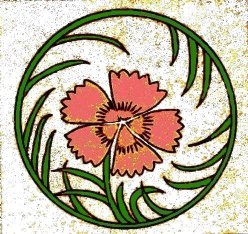 Sekichiku thru Sh |
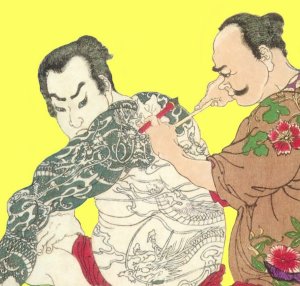 Si thru Tengai |
Yakusha thru Z |
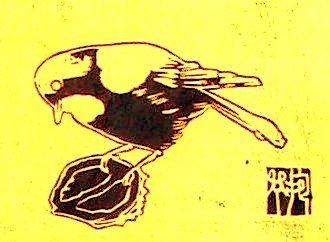
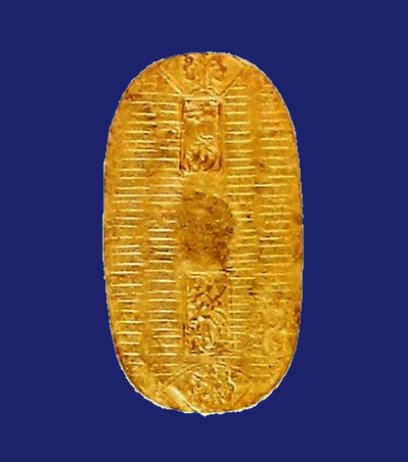
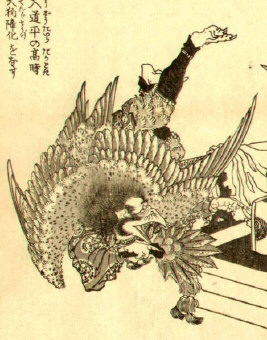
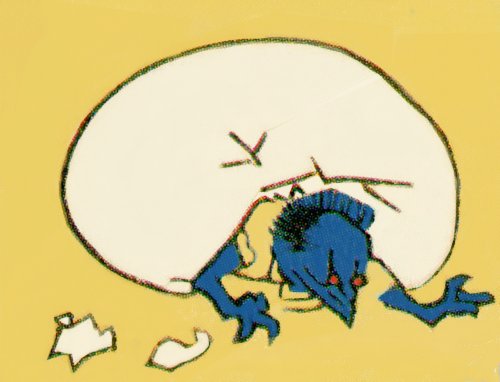
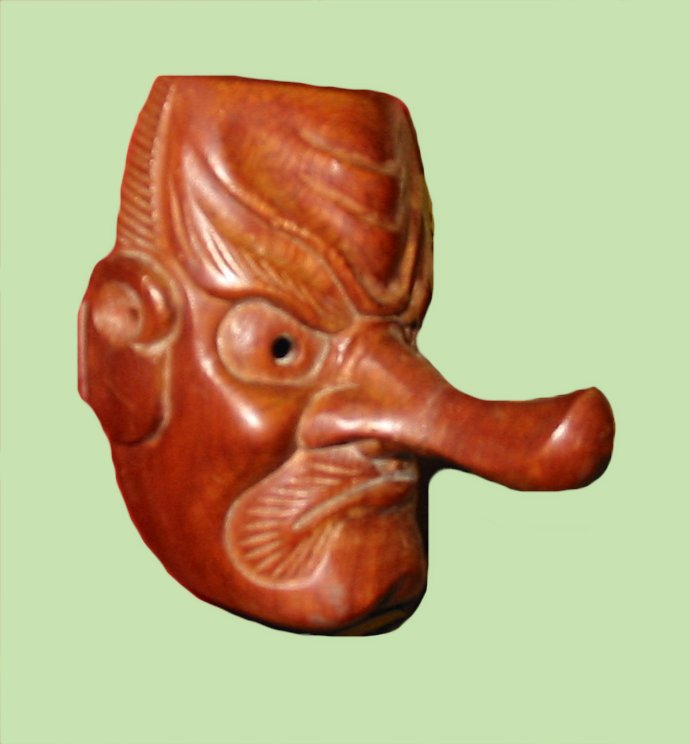
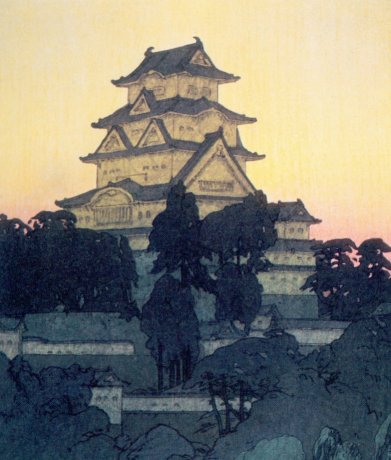
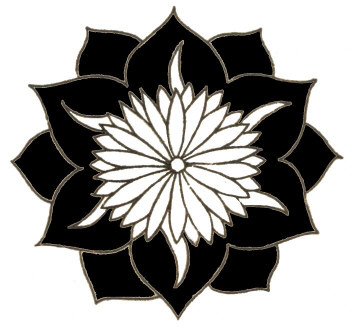
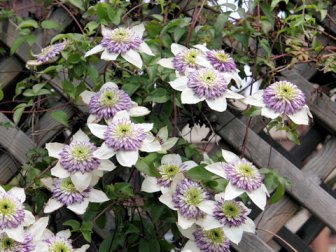
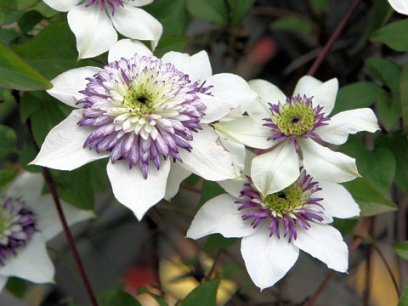
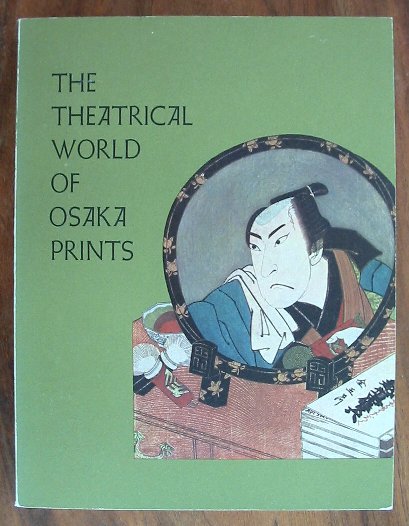
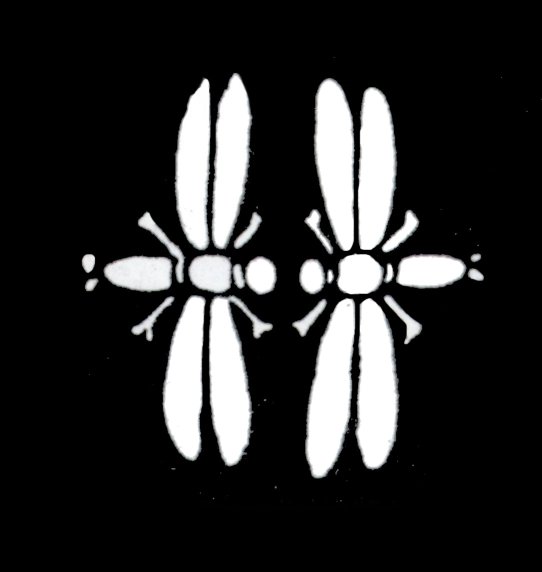
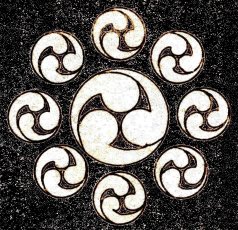
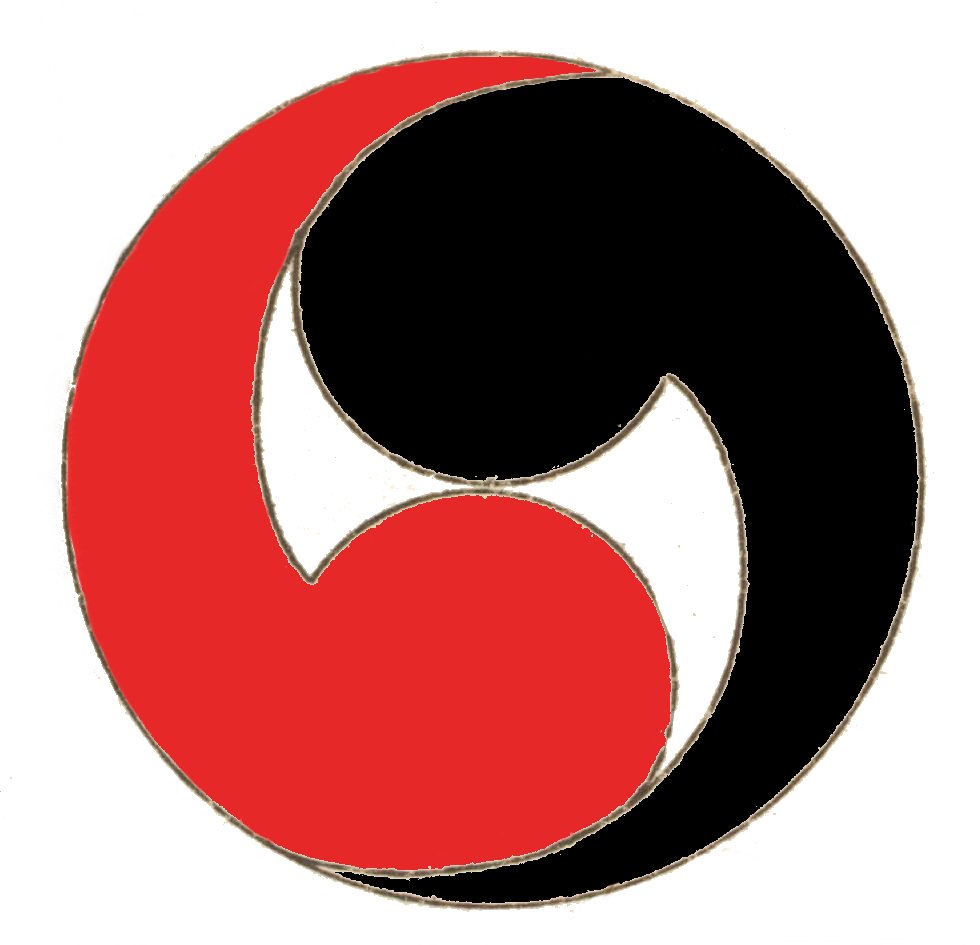
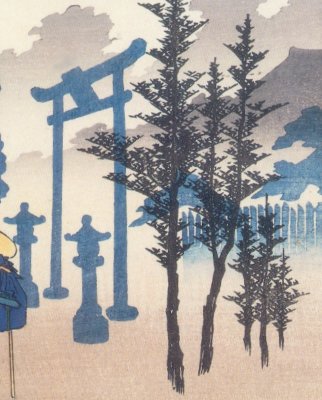
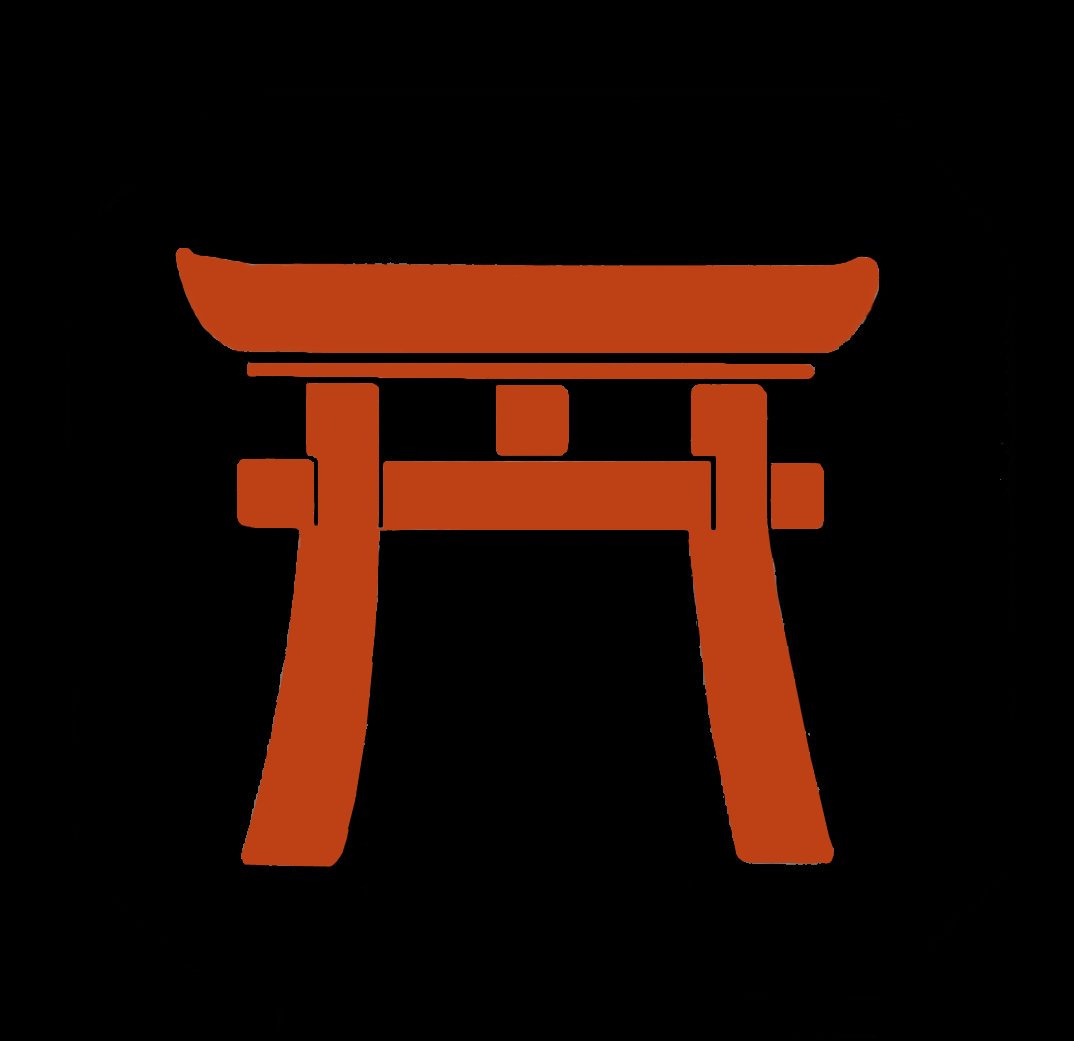
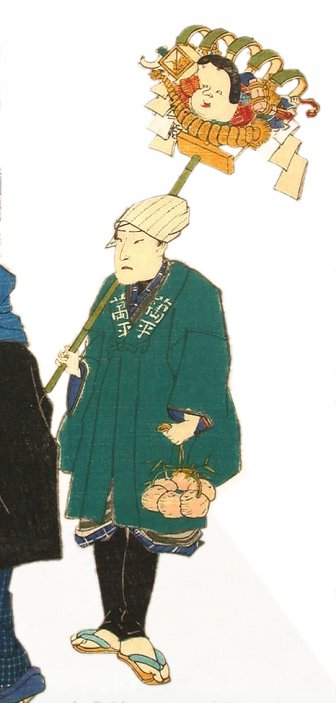
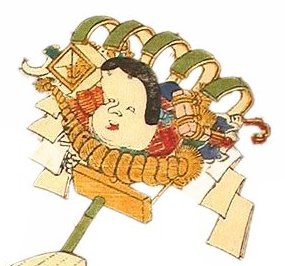
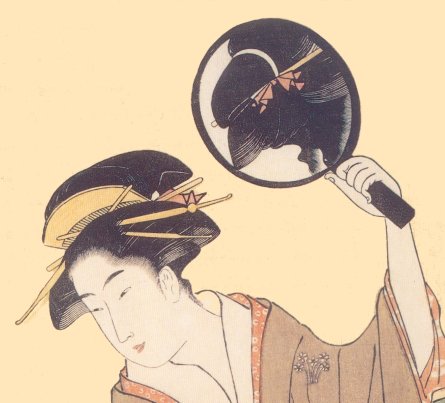
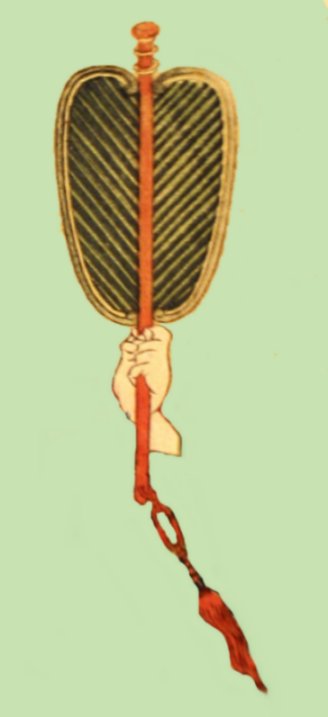
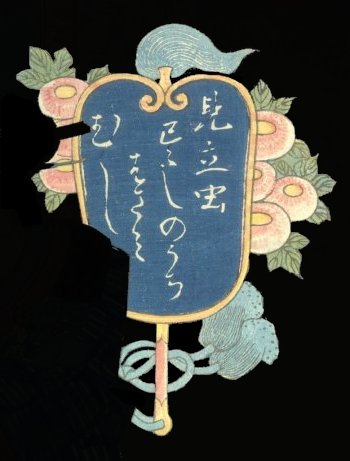
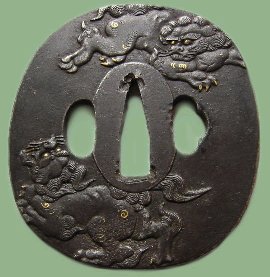
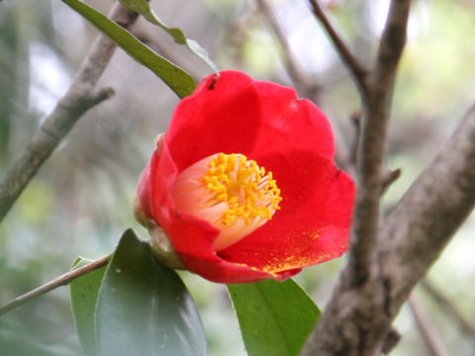
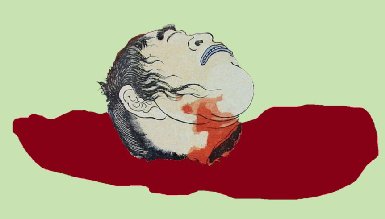

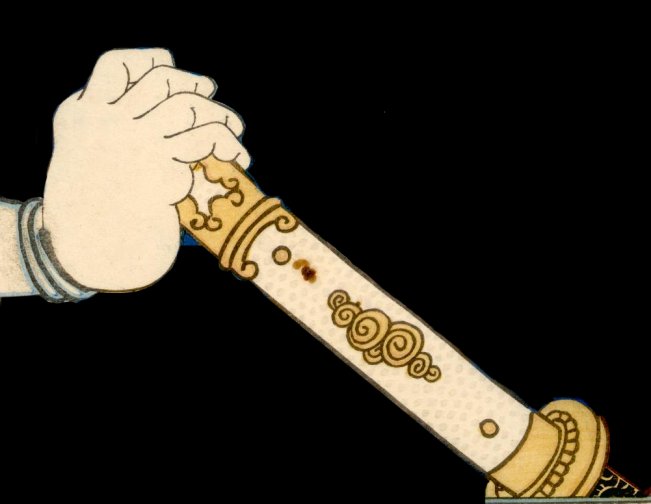
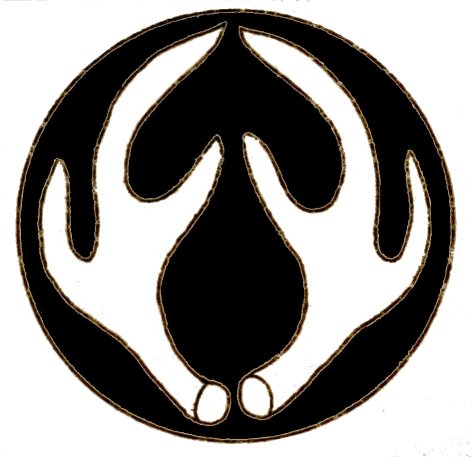
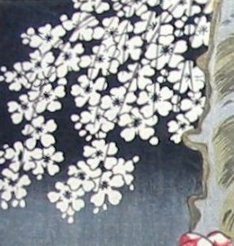
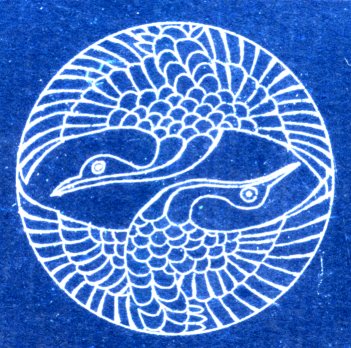
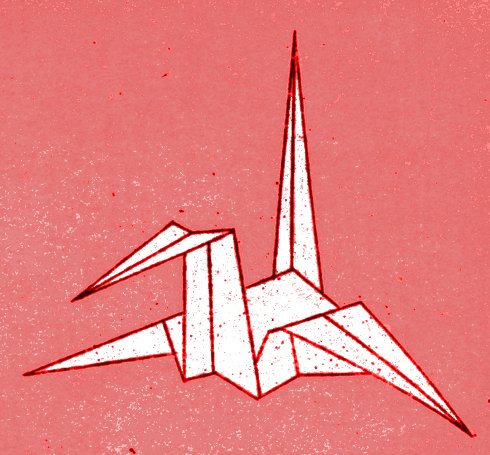

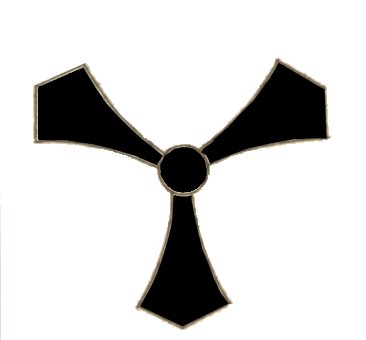
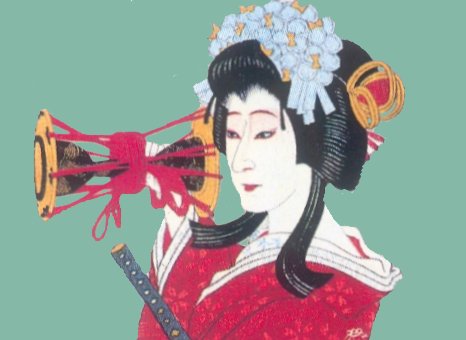
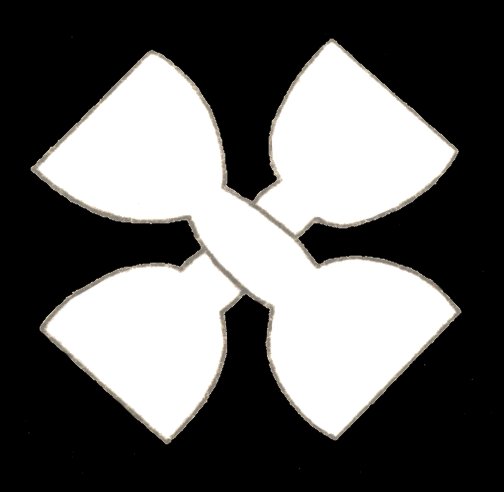
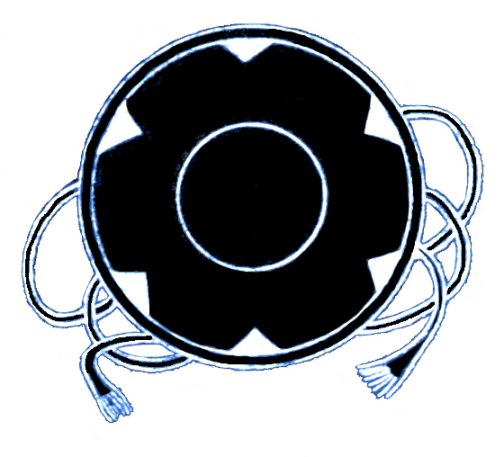
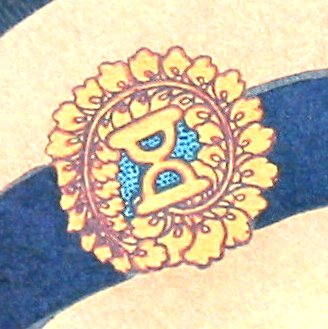
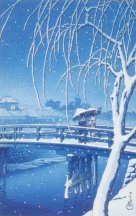
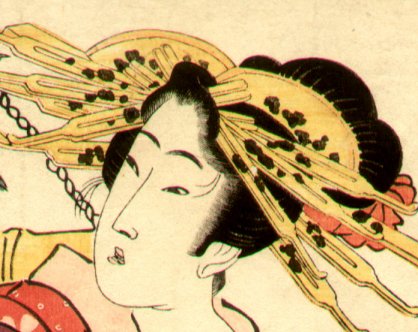


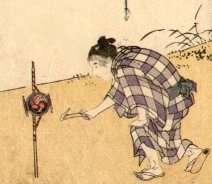
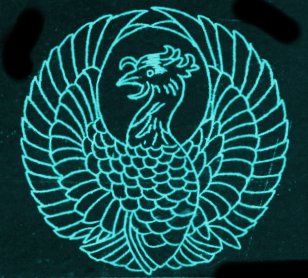
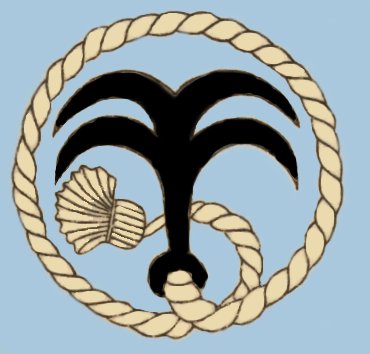
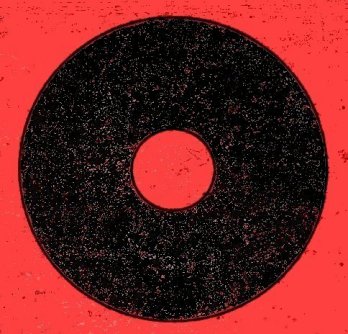
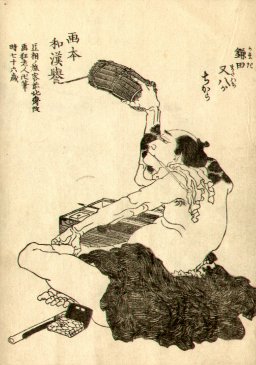
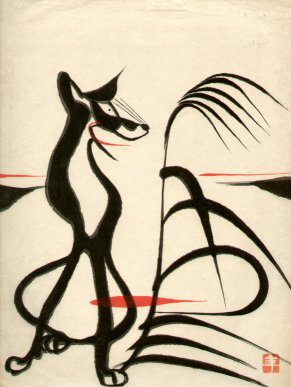
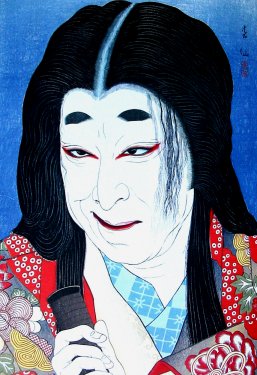
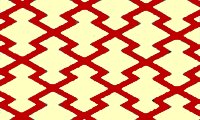
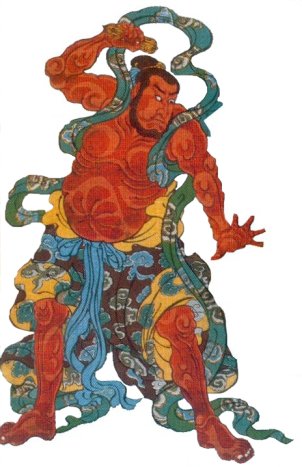
3.jpg)
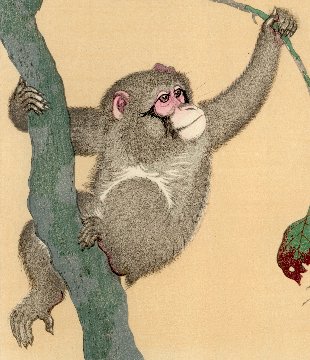
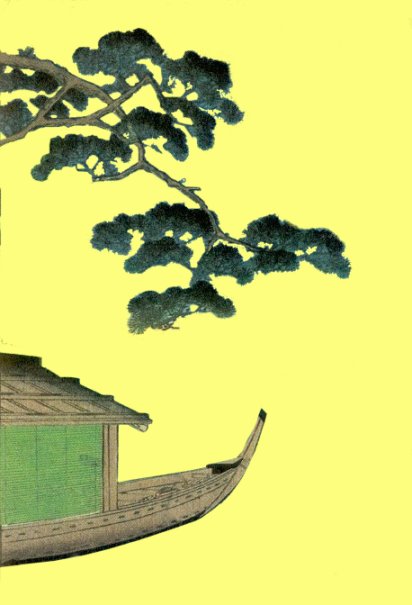
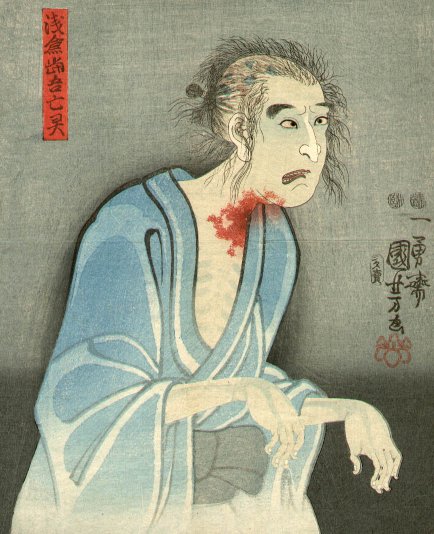
 HOME
HOME